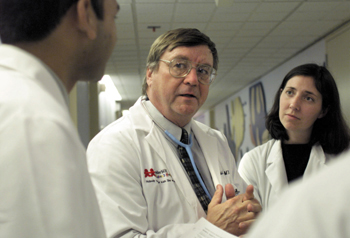
Dr. Arnold Strauss, chair of Pediatrics, believes that particular genes in children trigger heart disease. Strauss is one of the nation's leading authorities in pediatric cardiology research. (photo by Dana Johnson)
Doppler battles uterine fibroids
Three-dimensional color Doppler ultrasonography is now being used at Vanderbilt University Medical Center to assess the size and vascularity of uterine fibroids before and after angiographic embolization, a technique that chokes off the blood supply to the fibroid.
A group of 25 women with fibroids were evaluated last year by ultrasound at VUMC, both before and after embolotherapy, in an effort to predict which women will respond better to the technique than other surgical or medical treatments. Vanderbilt is the only medical center in the area using the combination of ultrasound and embolotherapy.
Fibroids, a growth of smooth muscle and connective tissue inside the uterus, are common. Up to 30 percent of women over the age of 45 have them and they are almost always benign, but can cause significant pain and pressure symptoms. They can also be associated with infertility.
The angiographic embolization of fibroids has become an effective alternative treatment to hysterectomy, myomectomy (removal of the fibroid) or the medical treatment of fibroids, said Dr. Arthur C. Fleischer, professor of Radiology and Radiological Sciences and lead author of the study that appeared last year in the Journal of Ultrasound Medicine.
"This is a breakthrough in the treatment of fibroids," said Fleischer, who was joined in the study by Vanderbilt Drs. Edwin F. Donnelly, Michelle G. Campbell, Nancy L. Lipsitz and Murray J. Mazer, who performs the embolizations. "Embolization is proving to be a very effective treatment for fibroids. But using ultrasound to determine the vascularity is what's unique here."
Typically, symptomatic patients with fibroids undergo hysterectomies, which require a hospital stay, recuperation, pain and possible post-operative complications. But there are new methods of treating fibroids without removing the uterus, including exposing them to laser or heat, or even using cryosurgery. There has recently been an emphasis on the medical treatment of fibroids, specifically the use of the drug lupron, to shrink fibroids. But the drug causes significant menopausal-like side effects in some patients.
Fibroid angiographic embolization involves feeding a catheter into the uterine artery and injecting polyvinyl alcohol, a solid embolic material.
"This lodges into the large artery feeding the fibroid and effectively chokes off the blood flow to the fibroid," Fleischer said. "There's some pain after the procedure and the patient is usually hospitalized one night with a pain medication drip, but the pain wears off after a couple of days. It's a very effective treatment."
To qualify for this treatment, the patient must be symptomatic and have urinary pressure or low hematocrits requiring transfusion. Patients who qualify for the treatment are typically those who would require a hysterectomy. "It's not just for any patient with a fibroid," Fleischer said.
Ultrasound is used to determine how vascular the fibroid is, its location and size.
"It seems the ones that are hypervascular, or have the most vessels, have responded the most to treatment," Fleischer said. Ultrasound is also used to evaluate the patients following the embolization procedure. This is effective in seeing how effective the treatment is and whether subsequent embolization is needed.
The results have been promising.
"All patients have had an excellent response to embolization. We found that these fibroids significantly decreased in size and vascularity. What we hope happens eventually is to have some way of determining which patient should go on medication and which patient should have the embolization, but that will require hundreds of patients before we can determine that," Fleischer said.
The study showed that the reduction in volume of a fibroid is preceded by a decrease in vascularity and fibroids judged to be hypervascular before embolization tended to show a greater reduction in size than those that were isovascular or hypovascular.
About 8,000 embolotherapy procedures have been performed worldwide over the past few years to treat uterine fibroids. Prior to that the technique was used mostly to treat excessive pelvic hemorrhage.













